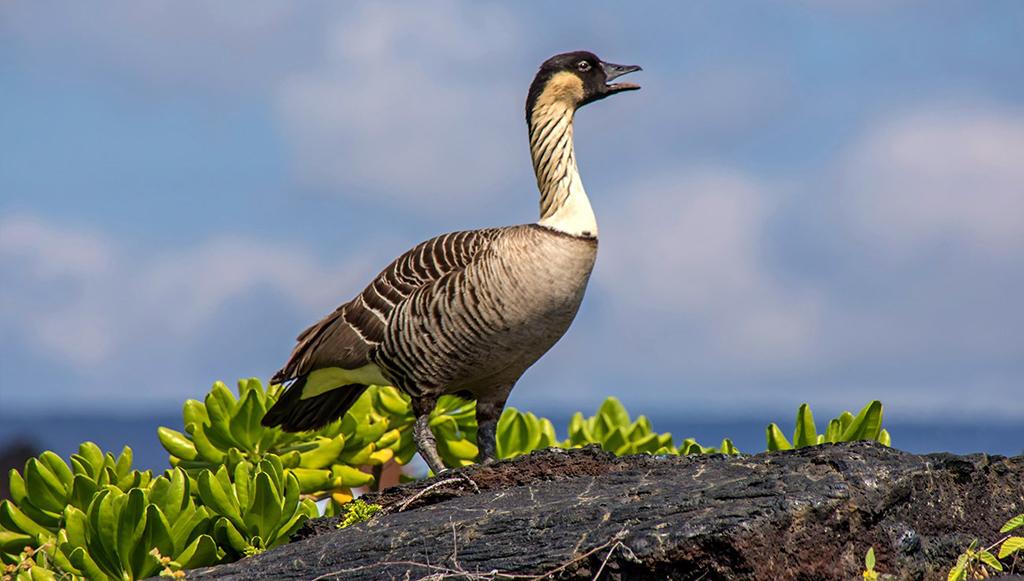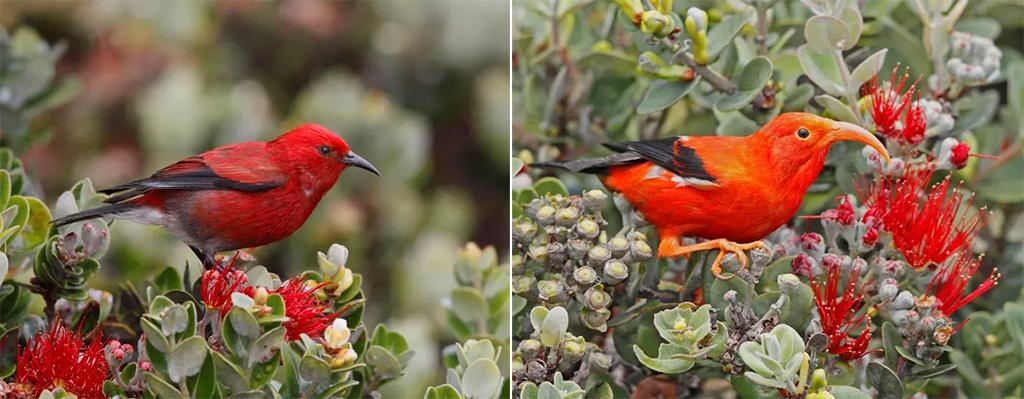Unlike such units as Yellowstone or Glacier national parks, the wildlife you are apt to spot at Hawai’i Volcanoes National Park is going to be on the smaller side: brightly colored (and endangered) birds, happy-face spiders, carnivorous caterpillars, endangered hawksbill and threatened green sea turtles, and one native land mammal: the ʻŌpeʻapeʻa (Hawaiian Hoary Bat). What the wildlife lacks in size, they more than make up for in unique looks and coloration.
What might you see during your visit to this park? Let’s take a look. For more detailed information, click on the wildlife links below.

The nēnē, the rarest goose in the world, Hawai'i Volcanoes National Park / NPS - Janice Wei
Nēnē (neh-neh) - This is the official state bird of Hawai’i and the rarest goose in the world. According to park staff:
Perhaps 25,000 nēnē existed in Hawai`i when Captain Cook arrived in 1778. By the mid-1940s only 50 birds remained. Populations were drastically reduced by introduced predators such as mongooses, cats and dogs; by foraging animals such as cattle, goats and pigs; by hunters; by introduced plants which compete with native food and cover plants; and by loss of lowland habitat.
In the 1970s, Hawai‘i Volcanoes National Park began a captive nēnē breeding and reintroduction program. But several factors hinder population increases. Mongooses and feral cats kill adults and goslings. Automobiles hit and kill nēnē along roadways. Nēnē that are attracted to the grassy fairways of golf courses suffer injury or death by errant golf balls. In upland habitats, nutrition is usually not adequate for gosling growth requirements.Nēnē will probably always need our help to survive. Currently, park staff use a variety of techniques to improve nēnē breeding success: controlling predators in nesting habitat, mowing pastures, closing sensitive brooding areas to the public, and maintaining predator-resistant enclosures in which free-flying birds can rest, feed, or nest.
You can do your part to help the continued survival of these threatened birds by not feeding them. Handouts make the nēnē accustomed to people and cars. Cars are the leading cause of adult nēnē deaths in the park.
Io (ee-yo) – This hawk species is native to Hawai’i and exclusively inhabits the Big Island.
Koaʻe Kea (koh ah eh kee yah) – This beautiful tropicbird has a long white tail (up to 16 inches / 40 cm) and may be seen flying over Kīlauea caldera and pit craters because they make their nests in the crater walls.

Koaʻe Kea tropicbirds, Hawai'i Volcanoes National Park / NPS file
‘Ua‘u - Hawaiian Petrel - The ʻuaʻu (oo ah oo), or Hawaiian petrel (Pterodroma sandwichensis), is a federally endangered native seabird, with an estimated 40 – 50 breeding pairs left.
ʻApapane and ʻiʻiwi (ah pah pah neh, ee ee wee) – These gorgeous, bright red-to-red-orange Hawaiian forest birds are honeycreepers, a group of small birds endemic to Hawaiʻi. Nectar is their primary food source.

The ʻApapane and ʻiʻiwi, colorful, rare honeycreepers, Hawai'i Volcanoes National Park / Jack Jeffrey via NPS
Insects may not always be thought of as “wildlife,” but they are, and Hawai’i is home to some very interesting insect species.

The Kamehameha butterfly, Happy Face Spider, and a carnivorous catterpiller, Hawai'i Volcanoes National Park / J. Robinson, D. Boyle
Pulelehua (Kamehameha Butterfly) – One of only two butterflies native to Hawai’i, the Kamehameha butterfly is Hawai’i’s official state insect and is named after the royal family that unified the Hawaiian islands.
Nananana Makakiʻi (Happy Face Spider) – Even if you are an arachniphobe, you cannot refute the whimsical look to this tiny little spider and it’s smiling face markings.
Carnivorous Caterpillars - Eighteen of the 19 species of Eupithecia moths in Hawaii have caterpillars (commonly referred to as inchworms) that possess the unique trait of eating active animal prey, namely insects.
You can take a whale watching boat tour to view the Koholā (humpback whales) and marvel at their huge tails slapping the water. Your boat tour operator might even drop an underwater microphone over the side so you can listen to the whalesong.
Beachside, you can get much closer to view and photograph the Honuʻea (Hawksbill Turtle), an endangered sea turtle that visits the Hawaiian Islands, or the Honu (Green Sea Turtle), a federally threatened species that is a more common sight than the hawksbill turtles.

Honu (green sea turtles) resting on a black sand beach, Hawai'i Volcanoes National Park / Rebecca Latson
You can also walk along the rocky beaches to see what gathers in the tide pools, and on the sandy beaches themselves, you might even spy a solitary ‘Īlio Holo I Ka Uaua (Hawaiian Monk Seal), one of the most endangered sea species in the world, sunning itself on that soft, warm sand.
ʻŌpeʻapeʻa (Hawaiian Hoary Bat)

The Hawaiian Hoary Bat, Hawai'i Volcanoes National Park / USGS - C. Pinzari
This bat is the only remaining native land mammal in Hawaiʻi, and is now listed as an endangered species. ‘Ōpe‘ape‘a in Hawaiian means “half-leaf", referring to the resemblance of the bat's open wing to part of the taro leaf. Its wingspan can grow to be about one foot (30 cm) wide. These nocturnal creatures roost not in caves or lava tubes, but in trees.
Hawai’i is an isolated location smack dab in the Pacific Ocean, but there are numerous non-native species which were brought in by people over the decades. Some of these species are cute (cats, which have contributed to the extinction of 33 native bird species), others are scary (fire ants, which leave nasty welts and can cause blindness and anaphylactic shock), and all threaten the native species endemic to Hawai’i.





